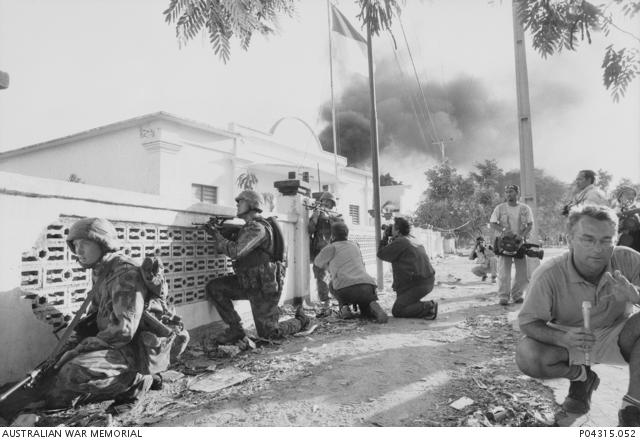Introduction to Focus: war & photography 1945-2006

Stephen Dupont, Members of Interfet and journalists, Dili, 1999. C1042338
On 6 August 1945, when the atomic bomb was unleashed above the city of Hiroshima, the world changed forever. Photographs of the devastation brought home in raw detail the shocking power of this ultimate weapon.
Photography has been bound in an intimate and changing relationship with war since its invention in the 19th century. Whether as a record, an analytical tool, propaganda or revelation, photography has played a critical part in forming our response to global and local conflicts, communicating these historic events through the mass media of press and television.
Photographers report the physical impact and the emotional effects of war, the tortured battleground, its deadly aftermath, and the civilian relief, humiliation and loss. Whether working in an official capacity, as freelance or affiliated photojournalists, or as serving soldiers, each photographer brings a direct and personal focus to their imagery of the human condition.
These images are often of people, whether military or civilian, operating at extreme levels of stress, where the waiting nerves, trained for action, are stretched taut with anticipation; others are jangled by the unexpected or dissolved in grief. Even the photographs of relaxation or entertainment hint at submerged depths of emotion and latent susceptibilities.
These photographers can take us beyond the surface of the image into new perceptions and responses to place, context, and emotion.
People involved in the exhibition
- Patricia Sabine - Exhibition curator
- Shaune Lakin - Exhibition co-curator
- Hans Reppin, Bob McKendry and Steve Burton - Image preparation
- Jude Savage, Jane Murray, Jason D'Arx and Charlotte Sarossy - Travelling exhibition coordinators
- Jos Jensen and Ian Wingrove - Exhibition designers
- Michael Thomas and Tina Mattay - Text editors